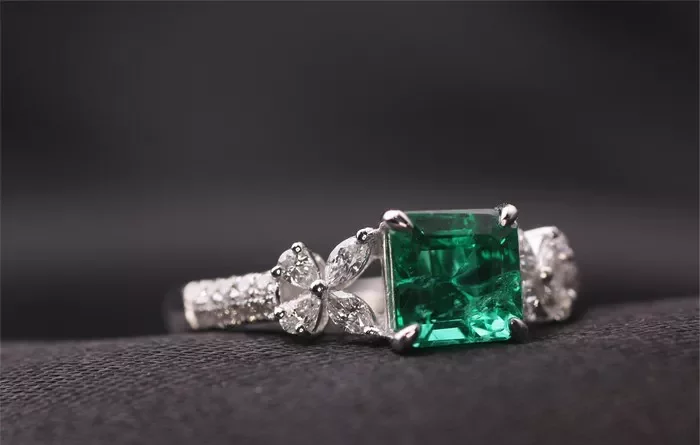Gemstones have captivated humanity for centuries, not just for their beauty but for their symbolism, rarity, and cultural significance. Among the vast array of gemstones, emerald and jade stand out for their unique allure and historical importance. While both are esteemed gemstones, they possess distinct characteristics that set them apart. In this comprehensive guide, we delve into the differences between emerald and jade, examining their color, luster, transparency, value, hardness, and mineral classification.
Color Differences:
Emerald, with its vibrant green hues, is renowned for its captivating color spectrum. Ranging from yellow-green to blue-green, emeralds exhibit a mesmerizing array of shades. The most coveted emeralds boast a pure, verdant green that exudes an inner glow, captivating the beholder with its richness and depth.
In contrast, jade surprises many with its diverse color palette. While green is the most commonly associated color, jade manifests in various hues, including white, pink, brown, black, violet, and creamy tones. The green in jade tends to be softer and more subdued compared to the intense greens of emerald, offering a tranquil and serene aesthetic.
Luster and Appearance:
Emerald and jade each possess a unique allure, distinguished by their luster and appearance.
Emerald: Emeralds are renowned for their captivating brilliance, reminiscent of a lush green oasis. Their luster shines and reflects light like glass, imparting a bright and intense glow. This vibrant radiance contributes to their allure, making them highly prized among gemstone connoisseurs.
Jade: In contrast, jade exhibits a more subdued yet equally enchanting charm. Known for its pearly, almost waxy appearance, jade does not boast the same level of shine as some other gemstones. Instead, it exudes a subtle elegance that captivates with its understated beauty. While not as flashy as emerald, jade possesses a unique allure that has captivated civilizations for millennia.
Value and Price:
The rarity and desirability of emerald and jade significantly influence their respective values and prices.
Emerald: Emeralds are among the most sought-after gemstones in the world, prized for their rarity and intense green color. As such, they command a considerable premium in the market, with prices often reaching astronomical heights for top-quality specimens. The allure of emerald lies not only in its aesthetic beauty but also in its scarcity, making it a coveted treasure for collectors and enthusiasts alike.
Jade: In comparison, jade is more accessible in terms of price, making it an attractive option for those seeking beauty on a budget. While certain varieties of jade, such as Imperial Jade, can fetch substantial sums, the overall cost of jade tends to be lower than that of emerald. This affordability has contributed to jade’s widespread popularity and enduring appeal across diverse cultures.
Hardness and Durability:
The hardness and durability of emerald and jade play a crucial role in their suitability for different types of jewelry and wear.
Emerald: Emeralds boast impressive hardness, ranking 7.5 to 8 on the Mohs scale. This exceptional hardness makes them less prone to scratching or chipping, rendering them suitable for everyday wear. Whether set in rings, earrings, or necklaces, emeralds can withstand the rigors of daily life while retaining their exquisite beauty and allure.
Jade: Jade exhibits a slightly lower hardness, typically ranging from 6 to 7 on the Mohs scale. While not as hard as emerald, jade is more resistant to breakage due to its dense and compact structure. This durability makes jade well-suited for carving intricate designs and crafting ornamental objects, such as sculptures, figurines, and beads. However, caution should still be exercised to prevent damage to this precious stone.
Mineral Classification:
Emerald and jade belong to distinct mineral classifications, each encompassing a diverse array of gemstones.
Emerald: Emerald is a specific variety of transparent green minerals known as beryl. Within the beryl family, emerald derives its distinctive color from trace amounts of chromium and vanadium. This unique chemical composition imbues emerald with its signature green hue, ranging from vivid grassy greens to deep forest tones.
Jade: Jade, on the other hand, is an ornamental mineral that encompasses two distinct minerals: nephrite and jadeite. Nephrite, the more common variety, is renowned for its creamy white to dark green hues and has been prized for millennia for its toughness and versatility. Jadeite, rarer and more valuable, exhibits a broader range of colors, including emerald green, lavender, and icy white. Both nephrite and jadeite hold cultural significance in various civilizations, symbolizing purity, harmony, and prosperity.
In summary, while emerald and jade share certain characteristics, such as their green hues and gemstone status, they each possess unique qualities that set them apart. From their color variations and luster to their transparency and mineral composition, emerald and jade offer a captivating glimpse into the diverse world of gemstones. Whether adorning a piece of jewelry or cherished for their cultural significance, emerald and jade continue to enchant and inspire generations with their timeless beauty and allure.


